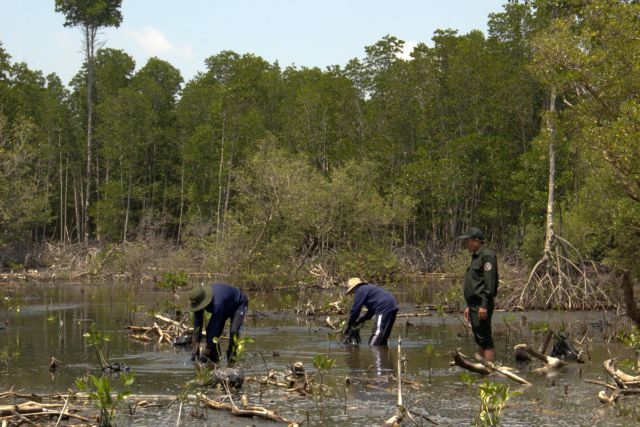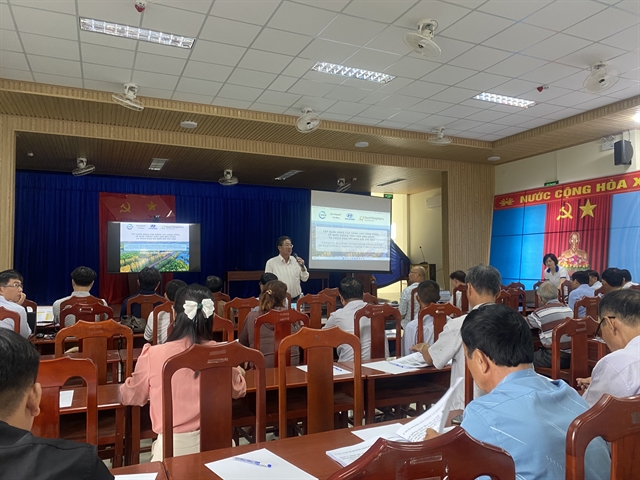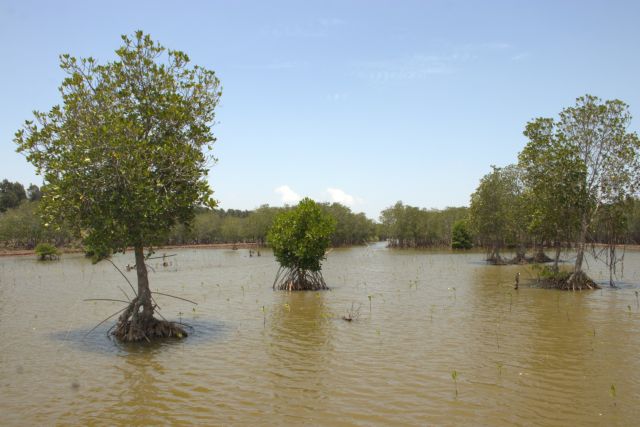 Environment
Environment


|
| Locals are planting Rhizophora mucronata mangrove trees for an IUCN reforestation project, themed “Scaling up NbS through mangrove restoration in Cà Mau Province", in Cà Mau Province on July 29. – VNS Photo Hồng Linh |
By Hồng Linh
CÀ MAU – The International Union for Conservation of Nature (IUCN) and authorities under the Cà Mau Province Department of Agriculture and Environment (DAE) have partnered to restore mangrove forests and train locals on sustainable aquaculture in Vĩnh Hậu Commune.
The Mekong Delta boasts a 774-kilometre coastline, however, this area faces challenges from climate change, including unpredictable weather that affects aquaculture, rising sea levels, and saltwater intrusion.
In particular, the mangrove forests of Cà Mau Province have been significantly impacted.
These mangroves are considered biological shields against extreme weather events and provide crucial breeding grounds for many commercially important aquatic species.
Their loss and degradation not only increases exposure to natural disasters but also threaten local livelihoods, undermining food security and economic sustainability.
There are also factors like unplanned deforestation for aquaculture, illegal logging, and natural phenomena such as tidal surges and coastal erosion, which impact the mangrove forests here.
To help remedy this situation, IUCN has launched a project from 2023 - 2027, themed “Scaling up NbS through mangrove restoration in Cà Mau Province”, funded by Hyundai Motor Company and Good Neighbors International.
This project aims to restore 160,000 mangrove trees, promote forest-friendly aquaculture, support mangrove-shrimp farms, and demonstrate the use of Other Effective Area-Based Conservation Measures (OECMs) to acknowledge conservation successes in aquaculture landscapes.
It currently assists 23 households by rehabilitating degraded mangroves in their contracted areas, providing them with shrimp seed stock, and offering training on integrated mangrove aquaculture.
The project is coordinated by the Management Board of Special-Use and Coastal Protection Forests under the Cà Mau the Department of Agriculture and Rural Development (DAE), which provides administrative and technical oversight to align with provincial land use plans.
By July 2025, over 80,000 Rhizophora mucronata mangrove trees were planted across 18 hectares in VĨnh Hậu Commune.
Planting efforts focus on mangrove-shrimp ponds and degraded coastal protection forests.
The remaining 80,000 trees are scheduled for planting the following year across 19 hectares in Nam Hải District.
Ensuring local livelihoods
Given the challenges of climate change for aquaculture, climate-adapted solutions are becoming increasingly important, which is why IUCN organised a training programme for locals of Vĩnh Hậu Commune on sustainable aquaculture on July 30.

|
| An IUCN training program on sustainable aquaculture for local residents in Vĩnh Hậu Commune on July 30. – VNS Photo Hồng Linh |
This aim is to introduce climate-adaptive aquaculture models, share experiences of integrated mangrove shrimp farms in the Mekong Delta, and update government support policies for farmers.
According to an IUCN expert, one of the comprehensive solutions involves enhancing resilience and adaptation.
This includes protecting and developing forests along with agriculture and the efficient use and prevention of resource degradation.
A representative of the Cà Mau Provincal Fisheries Control Sub-Department said climate change-adapted aquaculture models are applied in the Mekong Delta to cope with the impacts of climate change.
A common aquaculture model in coastal provinces is integrated mangrove-shrimp farming, or in other words, shrimp being raised under the mangrove canopy.
In this model, forests typically cover 50-60 per cent of the total farm area, with the remaining space used for shrimp ponds.
Shrimp in these areas are raised with a certain level of semi-intensive farming, relying on natural food sources.
They can be sold at a higher price when certified as ecological shrimp.

|
| An area for mangrove-shrimp farming in Cà Mau Province, a local project by famer Trần Văn Hồng, combines aquaculture with forest protection with the support of an IUCN project. – VNS Photo Hồng Linh |
Additionally, locals often cultivate crabs and shrimp together to increase economic benefits.
Another notable model is STC multi-species recirculating shrimp farming, which applies modern technology.
This allows for high-density stocking of up to 300 shrimp per square meter.
In this system, shrimp wastewater is directed through an eco-friendly filtration pond. This pond uses a combination of tilapia (to consume organic matter and algae), clams (to absorb excess nutrients), and microorganisms (to break down harmful substances) to clean the water.
Other aquaculture models include rice-shrimp rotation, intensive and semi-intensive farming of black tiger shrimp and whiteleg shrimp, integrated shrimp-seaweed farming, and all-male tilapia farming.
These models help reduce wastewater discharge into the environment, and convert waste into valuable biomass.
They also ensure a stable shrimp farming environment, reduce reliance on external water sources, and lower feed and chemical costs.
However, implementing these models also faces many challenges.
Vũ Hữu Trúc, a local who uses the integrated mangrove-shrimp farming model, said that that intensive industrial shrimp farming and industrial waste are polluting waters, making it hard for him to afford water sanitation and combine aquaculture with conservation.
He also noted that when leaves or diseased and dead trees fall into the water and water flow is poor, the accumulated organic debris pollutes the water, making it unsuitable for aquatic life.
This is compounded by the fact that households in protected forests are not permitted to prune or cut down trees independently.
To overcome these issues, an IUCN expert has proposed solutions including scientific research, upgrading infrastructure for disaster prevention, and practical measures to improve forest management and tidal water flow, all with government support.
Meanwhile, experts highlighted the importance of using high technology in aquaculture and linking production with consumption chains.
The government is providing support policies, including a sustainable aquaculture development plan for the Mekong Delta until 2030, which feature a project to upgrade infrastructure in aquaculture zones affected by climate change.
Additionally, the government offers credit policies for shrimp farming, provides insurance, and promotes the development of cooperatives as well as production and consumption linkages.
Businesses have also shown great concern for this conservation effort.
Among them, Minh Phu Seafood Corp, one of Việt Nam's largest seafood enterprises, currently provides international certifications for export-standard aquatic products, including mangrove and ecological shrimp.
Their ecologically certified shrimp are purchased at a higher price, which is a significant advantage for mangrove shrimp farmers in Cà Mau.
These efforts aim to help local communities secure their livelihoods while retaining and regrowing forests. – VNS




